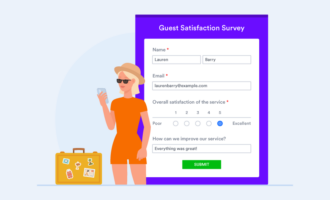Surveys are meant to help organizations gather relevant, accurate data so they can make informed business decisions.
To get that data, though, you have to ask the right questions. That means avoiding leading questions that influence respondents to answer a certain way. Leading questions skew survey results, negatively impact the validity of your survey, and impact your ability to make well-informed decisions for your business or organization.
In this article, we’ll review eight leading question types and share 28 leading question examples so you’ll know what you should avoid to create an unbiased survey. We’ll also explain why you should steer clear of leading questions, provide tips for how to avoid them, and talk about how you can use Jotform to create unbiased surveys.
A simple tip for spotting (and avoiding) biased leading questions
A leading question is one that either subtly or overtly influences a respondent to answer in a certain way because of the way the question is framed.
For example, a leading customer service survey question might be framed as: “How satisfied were you with our excellent customer service?”
In this case, the assertion that the customer service is, in fact, excellent makes this a biased leading question. Another way to phrase that question in a way that isn’t leading would be: “Please rate your satisfaction with our customer service on a scale of 1–5, from poor to excellent.”
8 types of leading questions with examples
Let’s get to know this line of questioning a little better by exploring eight specific types of leading questions. Then we’ll show you what they look like in practice with our list of 28 leading question examples so you can more easily identify and avoid them in your surveys.
1. Assumption-based leading questions
Assumption-based leading questions rely on preconceived notions about how respondents may feel. These questions often include phrasing with a positive bias that could influence how participants respond.
Examples:
- How much do you like our recent marketing campaign?
- How eager are you to try our new product?
- How much did you enjoy your recent shopping experience at our store?
- What did you love most about our improved product features?
2. Coercive leading questions
Coercive leading questions, also known as leading questions with tags because of their structure, include language that influences the respondent to agree with or confirm a statement, making it challenging for them to provide an alternate response.
- You enjoyed your recent stay at our hotel, right?
- You’re excited about our new product features, correct?
- Our customer service representative handled your issue quickly, didn’t they?
- Your recent visit to our spa was relaxing, wasn’t it?
- You don’t want to miss this opportunity to save on your purchase, do you?
3. Suggestive leading questions
Suggestive leading questions are framed in a way that makes a certain answer obvious or assumes agreement. If you’ve ever watched a courtroom drama, you’ve seen this kind of question in action: “You were at the scene of the crime that night, weren’t you?” Here’s how they play out in surveys:
- Don’t you agree that our company provides excellent products and services?
- Don’t you agree that our recent ad campaign was persuasive?
4. Scale-based leading questions
Scale-based leading questions employ a skewed rating scale that provides more positive than negative answer options. If three out of five potential answers mention “satisfied” or “agree,” as in the examples below, this increases the odds of receiving a favorable response. You can balance out the answer options in these examples by providing an equal number of positive and negative options.
- How satisfied were you with your recent visit to our store?
- Highly satisfied
- Satisfied
- Somewhat satisfied
- Dissatisfied
- Extremely dissatisfied
- How satisfied are you with our new product features?
- Extremely satisfied
- Satisfied
- Somewhat satisfied
- Somewhat dissatisfied
- Dissatisfied
- To what extent do you agree with the statement, “This company provides products/services that are beneficial to me”?
- Strongly agree
- Agree
- Slightly agree
- Disagree
- Strongly disagree
5. Direct-implication leading questions
Direct implication leading questions ask respondents to consider something that may happen if a condition or conditions are fulfilled. These questions have an if/then structure. They ask respondents how they would feel or what they would do if certain conditions were in place.
- If you found our recently added product feature valuable, should we add more new features?
- If you had an enjoyable stay at our hotel, would you recommend it to friends?
- If you enjoyed the conference, will you be attending again next year?
- If you enjoy dining here, will you share a review on social media?
6. Leading questions with interconnected or interrelated statements
This type of leading question presents a statement of fact or opinion followed by a question. Because the question is closely linked to the preceding statement, it may unduly influence respondents to agree, whether or not they actually do.
- Most employees enjoy working no more than 40 hours per week. How do you feel about this?
- The majority of your coworkers prefer a hybrid working arrangement. Do you?
- Since implementing our new in-office policy, many employees say they are happier and more productive. What are your thoughts?
7. Questions with absolutes
This type of question uses absolute terms like “always,” “never,” “all,” and “every,” which prevents respondents from providing more accurate, nuanced opinions and feedback.
- Do you always use our product to [the problem your product solves]? Yes or no?
- Do you always stay in our hotel when you are in San Francisco? Yes or no?
- Do you respond to every customer service survey you receive from us?
8. Double-barreled questions
A double-barreled question is another question type that can lead to misleading survey results. These questions inquire about more than one topic or issue in a single question, but they only allow one response. This makes it impossible to provide a clear answer, which skews results.
- How satisfied are you with the restaurant and spa at our hotel?
- Are you a team player who always helps your coworkers and seeks out extra duties?
- How would you rate your work environment and opportunities for advancement?
- How often do you use our latest product features and share your opinion of them with friends?
Reasons to avoid asking leading questions
There are several reasons you want to avoid asking leading questions in a survey. Here are a few:
- Leading questions are one of the biggest causes of survey bias, which can produce inaccurate data. Inaccurate data leads to a whole host of problems, such as those in the bullets below.
- Leading questions are also a major reason for low completion rates in surveys. Survey respondents might abandon a survey if they detect that questions seem to pressure them to respond a certain way.
- Leading questions create dissatisfaction among respondents when they feel overly influenced or manipulated into choosing a certain answer; this may reflect poorly on your brand, business, or organization.
- Because leading questions result in unreliable data, you won’t be able to use it to improve your products and services, which ultimately makes conducting the survey a waste of your time and effort.
- You need accurate, unbiased data to make informed business decisions. Inaccurate data can lead to lost profits, since you won’t know what business improvements to make or how to make them.
- Respondents may view leading questions as unethical, which could result in participant dissatisfaction, damaged trust, credibility, and reputation, and lost customers.
- Because leading questions inherently seek certain answers, you may not receive other useful, honest feedback that could help your business thrive.
Tips to help you avoid writing leading questions
There are multiple ways to ensure you’re not using leading questions, including being sure to avoid any of the question types highlighted above.
Keep these tips in mind:
- Employ neutral language that doesn’t influence respondents to answer in a particular way. (See examples in the leading question types and examples section above.)
- For multiple-choice and scale-based questions, be sure to provide answer options that include a balance of positive and negative responses.
- Avoid yes/no answers as much as possible.
- Don’t start questions with a biased statement.
- Include some open-ended questions that allow respondents to provide answers in their own words. Asking, “What are your thoughts on our new product features?” is a good example.
- Use clear, simple terms, rather than jargon or technical, complex language.
- Include “Prefer not to answer” or “other” answer options so that those who don’t feel comfortable answering certain questions will still complete the survey.
- Have an objective third party review your survey for bias before sharing it with respondents.
A powerful tool to help you create unbiased surveys: Jotform
Hopefully you’re now feeling more confident about developing surveys that leave out leading questions altogether. When you’re ready to get started with your survey, Jotform can simplify the process for you.
Jotform’s free drag-and-drop online survey maker makes it easy to create engaging online surveys. Simply add your own questions, set up conditional logic if you want, and share your custom survey online. A robust set of features makes it possible to engage users, boost completion rates, and easily track your survey data with Jotform’s real-time reporting and data analysis tools.
If you don’t want to build your survey from scratch, you can use one of Jotform’s free survey templates — there are over 1,000 to choose from — and customize it to suit your needs. You can easily add both short and long answer fields, which will help you avoid certain question types and encourage your respondents to share their feedback and answers without limitations.
Photo by Thirdman








































































































Send Comment: